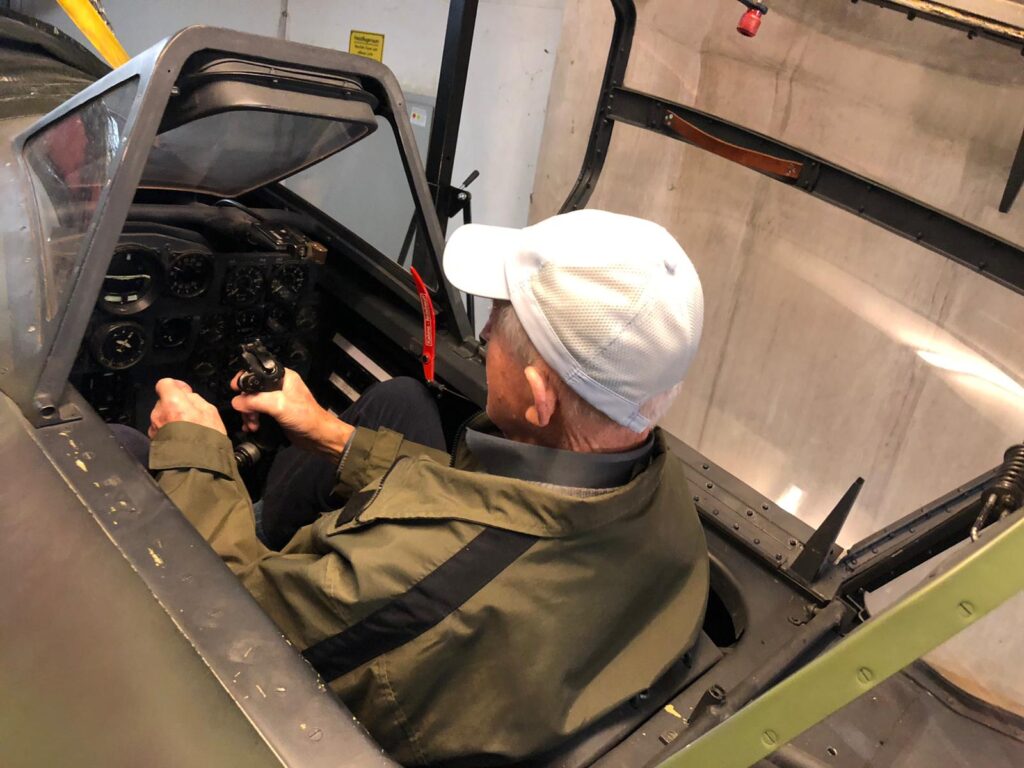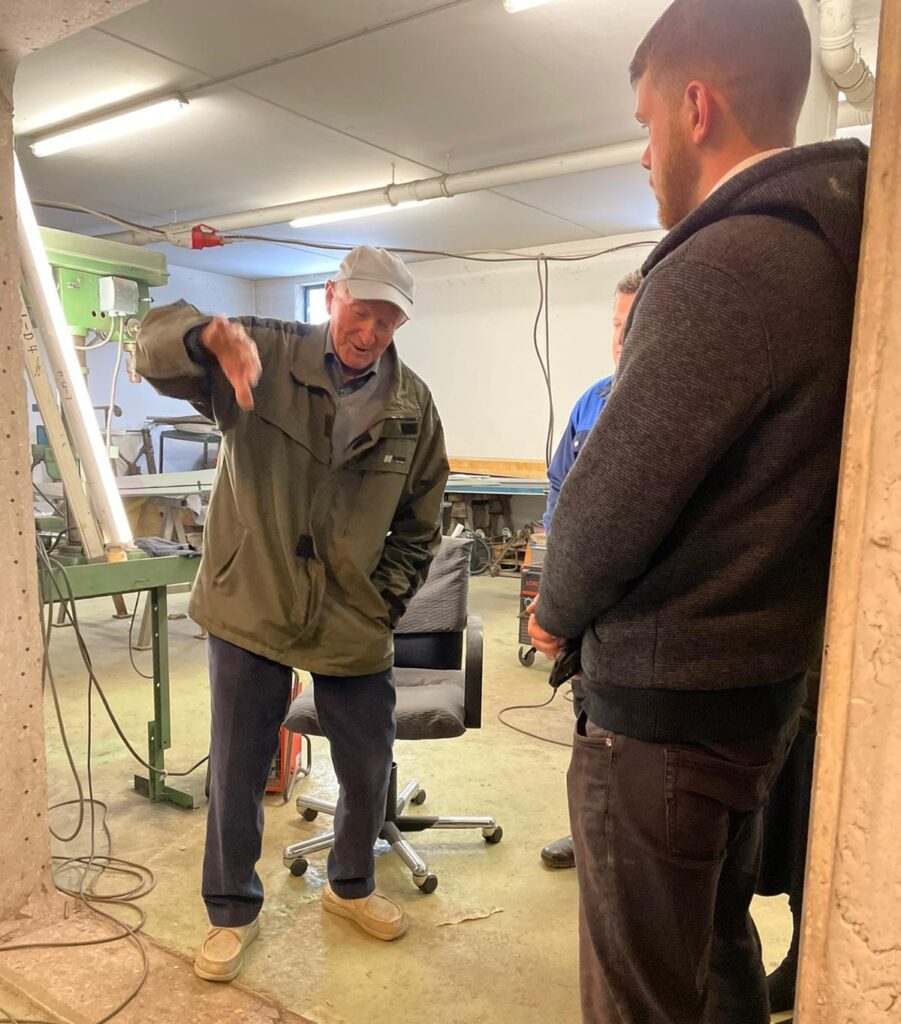In my search for living witnesses, I met Dr. August Werner, among others, in the summer of 2020. In 1941 he had volunteered for the Luftwaffe, was first called up for basic training in Austria and later assigned to a supply unit in Africa. After several attempts, his application to become an airline pilot was accepted and he earned his pilot's license in France. Detached to Fighter Squadron 54 "Totenkopf" in late 1943, he flew missions as part of Operation "Ibex" against England. Piloting a Ju-88, he took part in numerous minelaying missions in the English Channel and was promoted to the rank of sergeant. After the Allied invasion, he flew missions against the landing forces and was awarded EK1 and EK2 as well as the Frontflugspange. Several times his aircraft was badly damaged, once narrowly managing a landing after a third of the left wing sheared off following a collision. At the end of 1944, his squadron was converted to the Me-262 and he was initially responsible for ferrying aircraft from the Messerschmitt factories to the ports of operations. He completed over 60 flights on the Me-262, but was forced to make two emergency landings due to the poor workmanship of the final war production. In the Würzburg area, he managed to crash-land without too much damage. At the end of the war he was at the Prague-Rusin airfield with the "Nowotny" squadron and only narrowly escaped the Russians by means of an adventurous flight to Bavaria. After only ten days in American captivity, he was quickly released.

August Werner found his way back to civilian life, earned a doctorate in veterinary medicine and started a family. The memories of his time in the service never left him. The old portrait picture in Luftwaffe uniform adorned his hallway, the airman's badge lay dusty on the shelf. He did not like to talk about the war, but his enthusiasm for flying was never completely extinguished. At Christmas time 2020 we were able to give him another great pleasure. With the help of friends, some contacts and a trip through half of Germany, it was possible to reunite the former jet fighter pilot with his fighter plane once again after decades. In awe and with shining eyes, he stood in the workshop hall in front of the fuselage of the fighter, which nevertheless appeared very enormous. It took no great persuasion and he swung himself into the pilot's seat once again. At the controls of such a plane, he and his comrades had made aviation history. Despite the gaps in his memory, all the instruments still looked so familiar and the control stick still felt good in his hand. None of us present could understand what August must have been thinking when he once again looked through the almost ten centimeter thick armored glass of his jet fighter. What must he have seen through that window at that time?



During our conversations, which had otherwise often been very silent, the great storytelling now began. Technical details and special features of the machine, but also the anxious waiting for the return of the comrades after a mission were described. Almost always one was missing! Wild gesticulating flight maneuvers with the Ju-88 over the English Channel were shown. After a little more than two hours the excursion was over and with a last look back at his plane he started his journey home.

I would have liked to document the memories of Dr. August Werner as a book. Unfortunately, however, he could only remember his time of service in fragments, older records were not available. Nevertheless, I remember the conversations very fondly, but especially the excursion with him. Dr. August Werner passed away on December 23, 2022, after he was still able to celebrate his 100th birthday with his family. May he rest in peace!
Adrian Matthes, Erlangen, März 2023

Back in the cockpit of an Me-262 after 75 years
Hallo Herr Matthes,
ich bin über das Flugzeugforum auf ihre Webseite aufmerksam geworden. Nach dem Durchsehen der Beiträge viel mir dieser Beitrag über Dr. August Werner besonders auf.
Ich befasse mich auch gerne mit der Luftkriegsgeschichte in meinem Raum (LK Erding) und besonders mit dem Fliegerhorst in der Gegend.
Interessant an der Erzählung von Dr. August Werner ist, daß er beim KG 54 war, 262 flog, am Ende des Krieges im Prag Rusin war und sich dort abgesetzt hat nach Bayern.
Da kommen mir einige Bilder aus Erding ins Gedächtnis.
Interessant wäre ob da noch einige Details zur Flucht erzählt wurden!
1. Wie hat er Prag verlassen (Flugzeug)?
2. Wenn mit Flugzeug, mit welchem Typ?
3. Wann hat er sich aus Prag abgesetzt?
4. Wo gelandet?
5. Existiert noch das Flugbuch?
6. Wurde der Gefechtsverband Hogeback erwähnt.
Würde mich über eine Antwort von Ihnen freuen.
MfG
Josef Maier
Danke für die Anfrage!
Herr Dr. Werner ist inzwischen leider verstorben. Sein Gedächtnis war in den letzten Jahren leider sehr lückenhaft, deshalb war es auch leider nicht mehr möglich ein Buch mit ihm zu schreiben. Soweit ich das meinen Gesprächsnotizen mit ihm entnehmen ist er mit einem Flugzeug aus Prag geflohen. Das Datum kann ich nicht genau sagen, was war aber kurz bevor der Flugplatz eingenommen wurde. Er ist ganz nah bei seinem Heimatort gelandet und dann umgehend in Kriegsgefangenschaft bei den Amerikanern geraten.
„Hogeback“ hat er nicht erwähnt.
Er hatte nur noch wenige Fotos seiner Dienstzeit. Das meiste seiner Unterlagen wurde mit dem Tross in Prag vernichtet.
Ich weiß das ist dürftig, aber genaueres konnte ich selbst leider nicht herausbekommen.
MfG
Adrian Matthes
Herzlichen Dank für ihre Antwort!
Das ist immerhin etwas.
Entschuldigen Sie wenn ich nochmal Nachfrage.
Wissen sie den Flugzeugtypen den er flog bei seinem Heimflug?
Wo war sein Heimatort? Grobe Angabe reicht.
MfG
Josef Maier
Er kam aus der Gegend von Augsburg. Ich meine er hat gesagt Me 262…. aber er war schon so durcheinader, dass diese Angabe auch anzuzweifeln ist. Ich halte es für unwahrscheinlich, dass eine Me 262 mal eben irgendwo landet…
Bei Giebelstadt hat er eine Me 262 auf einen Acker gesetzt Ende 44…das konnte ich belegen und nachweisen. Mit einer Ju 88 hatte er mal einen Funkturm gestreift und eine Bruchlandung gemacht, auch das ließ sich belegen. Zum Flug bei Kriegsende habe ich nichts gefunden.
Grüße
Adrian Matthes
Nochmals herzlichen Dank!
Das sind aber interessante Angaben für mich.
Zu möglichen 262 Flügen zu Kriegsende, da möchte ich anmerken es gab durchaus Flüge mit der 262 kurz vor oder nach Kriegsende. Zb. Landung in Faßberg oder Me 262 A-2a V555 Weimar-Nohra , sogar bis in die Schweiz (Mutke) Me 262A Flugplatz Dübendorf. Diese originale 262 steht heute im DM München.
Also das könnte durchaus möglich gewesen sein.